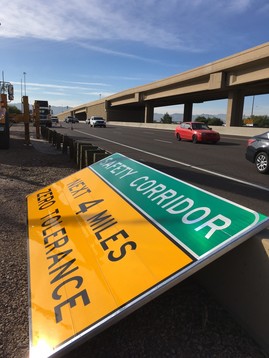 PHOENIX – This week, Arizona motorists will see new signage
designating segments of some state highways as Safety Corridors. By the end of
December, motorists may also notice an increased law enforcement presence in
these Safety Corridors.
Safety Corridors are highway segments that have more
crashes, injuries and deaths than would ordinarily be expected. Over the next
two months, the Arizona Department of Transportation, Arizona Department of
Public Safety and Governor’s Office of Highway Safety will implement four
Safety Corridors in Arizona, aiming to reduce crashes, severe injuries and
traffic fatalities.
“These segments were selected because they have
higher-than-average instances of speeding, aggressive driving, impaired driving
and lack of seat belt use,” said Brent Cain, director of ADOT’s Transportation
Systems Management and Operations Division. “Those are the leading factors in
traffic deaths, and decreasing their occurrence makes the roads safer for
everyone.”
Motorists will see new signs signaling they are entering and
leaving a Safety Corridor, as well as signs that alert drivers that there will
be zero tolerance for violations in a corridor.
“There will be strict enforcement of driving laws with zero
tolerance for violations,” said DPS Lt. Col. Daniel Lugo. “If drivers obey the
speed limit and other laws, there will be fewer crashes.”
The Safety Corridors will launch in two phases, with each
including an urban and rural segment. Sign installation in the first phase
begins today, Monday, Dec. 12, and will be completed by Dec. 20. Work on the
second phase is scheduled to begin and be completed in January 2017.
·
Phase
One
o
Interstate
10 (urban): Four-miles from the I-17 Stack to SR 51/Loop 202 Red Mountain
Mini-Stack (mileposts 143-147)
o
Interstate
10 (rural): Twenty-three miles from Loop 202 Santan Freeway to State Route 187
(mileposts 162-185)
·
Phase
Two
o
US
60 (urban): Thirteen miles from Loop 101 Price Freeway to Loop 202 (mileposts
177-190)
o
Interstate
40 (rural): Twenty-three miles from Kingman east to US 93 (mileposts 49-72)
A grant from the Governor’s Office of Highway Safety helped
support establishing these Safety Corridors.
“The Safety Corridors will make traveling safer for
everyone,” said Alberto Gutier, director of the Governor’s Office of Highway
Safety. “If you already obey driving laws, you have nothing to worry about and
can enjoy safer travel. If you speed, drive aggressively or break other driving
laws, you will face the consequences of zero tolerance enforcement.”
Safety Corridor segments were selected by reviewing historic
crash data related to driver behavior and input from law enforcement. This is a
pilot program that will remain in place for at least one to two years. After
that, the partner agencies will review their effectiveness and consider whether
to add Safety Corridors.
|